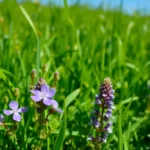When we think about weeds, we often picture unsightly plants choking out our carefully cultivated gardens. But what if we told you that some of nature’s most stunning purple blooms are actually considered weeds? These resilient plants don’t just survive – they thrive in conditions where other flowers would wither and die.
We’ve discovered that many of these so-called “weeds” with purple flowers are actually beautiful additions to any industry. From the delicate violet petals of wild violets to the bold purple spikes of purple loosestrife, these hardy plants offer vibrant color without the fuss of traditional garden flowers.
Understanding which purple-flowered weeds grow in your area can transform how you view your outdoor space. Instead of fighting against nature’s choices, we can learn to appreciate and even cultivate these tough, gorgeous plants that bring effortless beauty to our yards year after year.
Common Dandelion Look-Alikes: Purple-Flowered Weeds That Fool Homeowners
Many homeowners mistake these purple flowering weeds for dandelions at first peek, only to discover they’re dealing with entirely different plants that require unique identification and management approaches.
Wild Violet Identification Tips
Heart-shaped leaves distinguish wild violets from dandelions immediately, creating one of the most reliable identification markers we can use. The leaves grow in distinctive clumps rather than the rosette pattern typical of dandelions, making them easy to spot once you know what to look for.
Purple or white flowers appear on separate stems from the foliage, standing about 3 to 6 inches tall during their blooming period from March through May. Each flower displays five petals with the bottom petal featuring darker purple veins that guide pollinators toward the center.
Underground rhizomes spread these perennial weeds throughout lawns and garden beds, creating new colonies that can cover substantial areas within a single growing season. The root system differs completely from dandelion taproots, making manual removal more challenging since broken rhizome pieces can regenerate into new plants.
Moisture preference helps us locate wild violet populations in consistently damp areas like drainage ditches, shaded lawn sections, and spots near downspouts or irrigation systems.
Ground Ivy Recognition Features
Scalloped round leaves appear opposite each other on square stems, creating the distinctive appearance that separates ground ivy from both dandelions and wild violets. The leaves measure approximately 1 to 2 inches across and emit a minty fragrance when crushed between fingers.
Creeping growth habit allows this perennial weed to form dense mats across lawn surfaces, spreading through runners that root at each node point they contact with soil. Ground ivy thrives in shaded areas where grass struggles to establish thick coverage.
Small purple flowers bloom in clusters of 2 to 4 along the stem during April and May, measuring only about 1/2 inch long with a distinctive funnel shape. The flowers appear much smaller than wild violet blooms and grow directly from leaf joints rather than on separate stems.
Evergreen nature keeps ground ivy visible throughout winter months when most other weeds die back, making identification possible year round in temperate climates. This characteristic makes it particularly noticeable during dormant grass seasons when its green mat stands out against brown turf.
Invasive Purple Blooming Weeds That Spread Rapidly Across Lawns
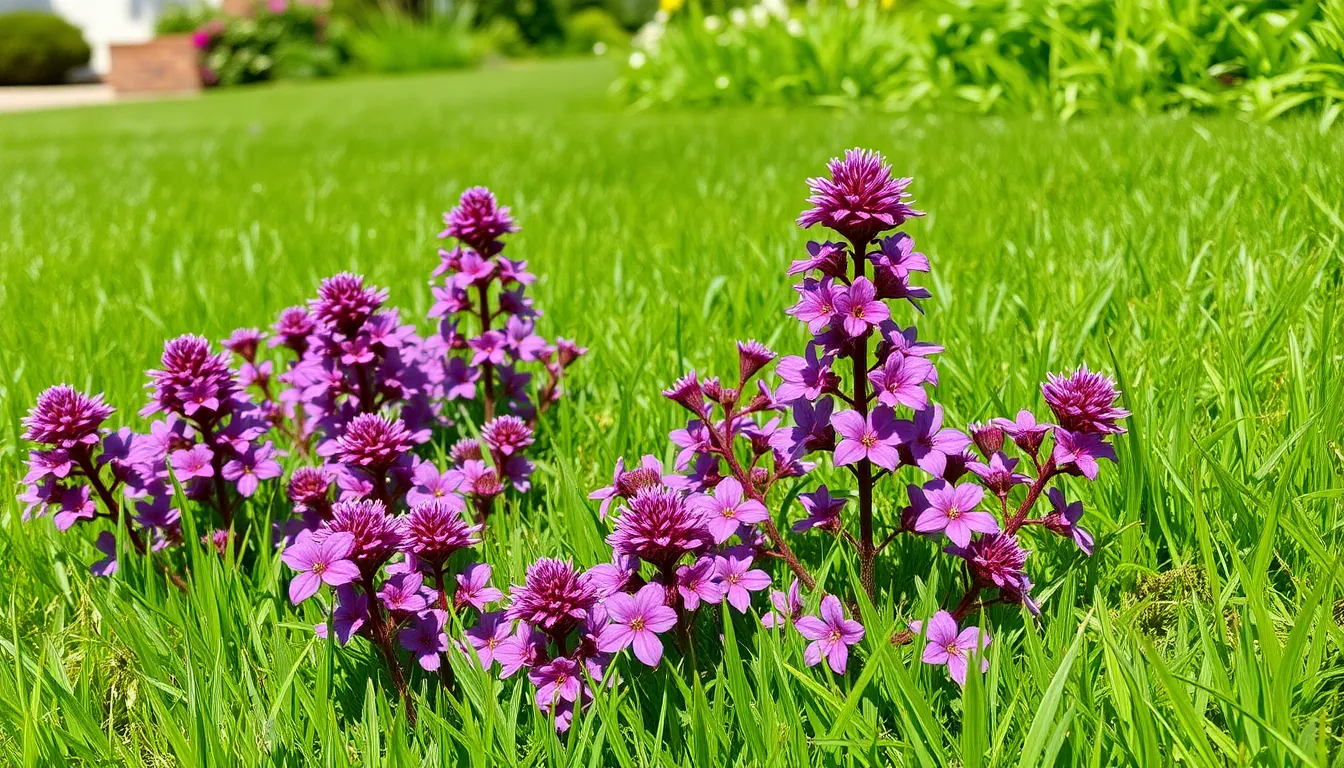
Several aggressive purple flowering weeds pose important challenges for homeowners seeking pristine lawns. Understanding their growth patterns helps us develop effective control strategies.
Purple Deadnettle Growth Patterns
Purple deadnettle establishes itself as a winter annual that germinates during fall months and produces vibrant blooms throughout spring. Winter temperatures don’t phase this hardy weed as it continues developing its root system beneath the soil surface.
Growth Timeline:
- Fall germination occurs in disturbed garden soils
- Spring flowering produces distinctive two-lipped purple blossoms
- Shallow root systems make manual removal feasible
- Seeds disperse quickly across mulched garden areas
Manual pulling works effectively because purple deadnettle develops relatively shallow roots compared to perennial weeds. Tilling disrupted soil areas before fall germination prevents establishment in garden beds and landscaped zones.
Henbit Invasion Characteristics
Henbit demonstrates remarkable adaptability as another winter annual with aggressive spreading capabilities across residential lawns. Quick germination gives this weed a competitive advantage over slower developing grass species.
Invasion Patterns:
- Rapid seed production creates multiple generations per season
- Disturbed soil conditions provide ideal establishment opportunities
- Dense colonies form through prolific self-seeding
- Cold tolerance allows year-round presence in mild climates
Regular lawn maintenance including proper fertilization and overseeding helps crowd out henbit before it establishes dominant colonies. Removing seedlings during their early growth stages prevents mature plants from producing thousands of seeds that fuel future invasions.
Native Purple Wildflowers Often Mistaken for Troublesome Weeds
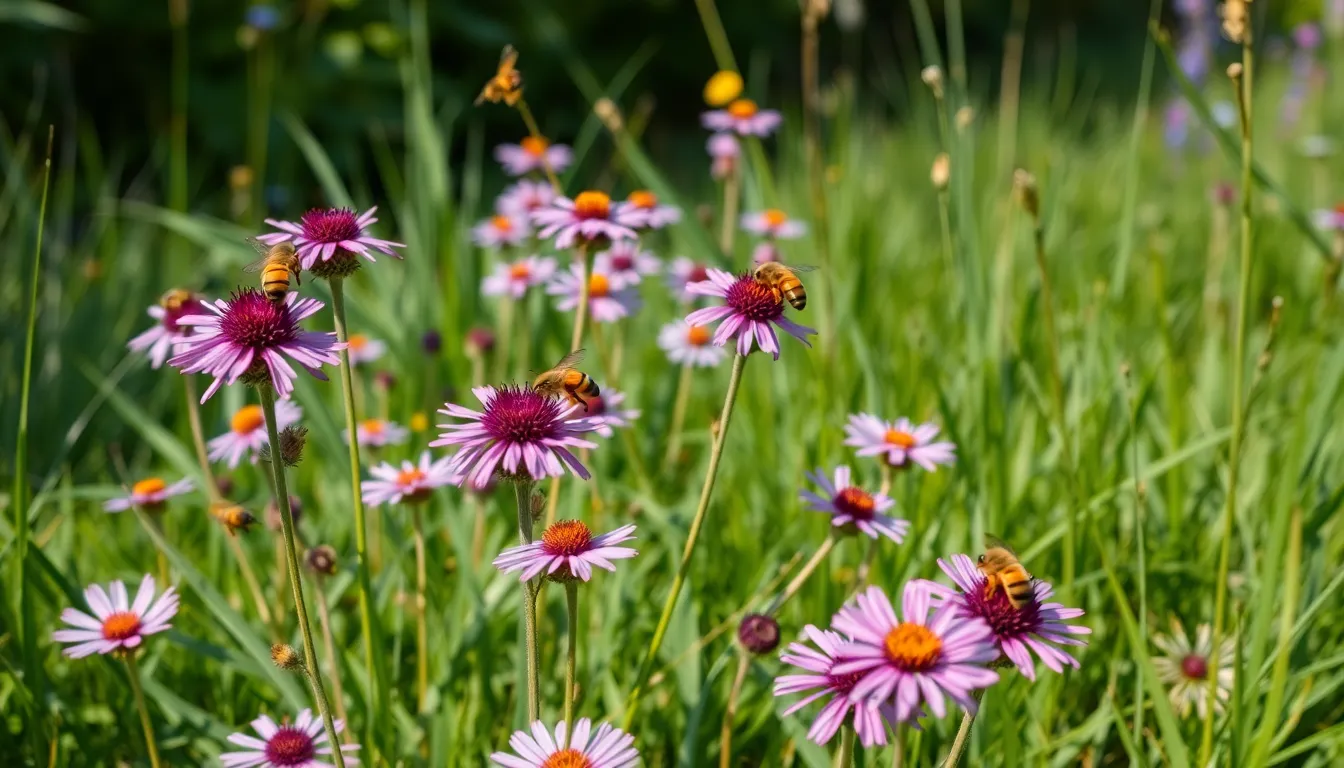
Many homeowners encounter beautiful purple flowering plants in their yards and immediately assume they’re dealing with invasive weeds. We’ve discovered that several native wildflowers with stunning purple blooms often get unfairly labeled as troublesome plants due to their vigorous growth patterns and ability to thrive in disturbed areas.
Self-Heal Medicinal Properties
Self-Heal (Prunella vulgaris) represents one of nature’s most underappreciated purple flowered plants that homeowners frequently target for removal. This low growing wildflower produces small purple blooms and contains powerful healing compounds including rosmarinic acid, triterpenoids, and flavonoids.
Traditional medicine has utilized Self-Heal for centuries due to its remarkable anti-inflammatory, antiviral, and antioxidant effects. Wound care applications benefit significantly from this plant’s natural healing properties, while its immune supporting qualities make it valuable for overall health maintenance.
We often find Self-Heal thriving in lawns and garden edges where its spreading habit creates dense patches of purple flowers. Rather than viewing this plant as a weed, we can appreciate its dual role as both a natural medicine cabinet and pollinator attractant in our outdoor spaces.
Wild Bergamot Beneficial Qualities
Wild Bergamot (Monarda fistulosa) stands out among native purple wildflowers with its showy lavender colored blooms that create stunning displays throughout summer months. Bee Balm, as it’s commonly known, attracts essential pollinators including bees, butterflies, and hummingbirds to our gardens.
Herbal medicine practitioners have long valued Wild Bergamot for its digestive and respiratory benefits when brewed into therapeutic teas. The plant’s natural compounds, thymol and carvacrol, provide antiseptic and antimicrobial properties that support various health applications.
| Native Purple Wildflower | Common Names | Primary Benefits |
|---|---|---|
| Self-Heal | Heal-all, Woundwort | Anti-inflammatory, wound healing |
| Wild Bergamot | Bee Balm, Horsemint | Pollinator attraction, digestive support |
| Wild Petunia | Four o’clock | Erosion control, wildlife habitat |
| Prairie Onion | Wild Garlic | Edible bulbs, soil stabilization |
Ecological roles make these purple flowering natives incredibly valuable for supporting local wildlife populations and maintaining healthy soil systems. We can transform our perspective by recognizing these plants as beneficial wildflowers rather than problematic weeds that need immediate removal.
Low-Growing Purple Weeds That Thrive in Poor Soil Conditions
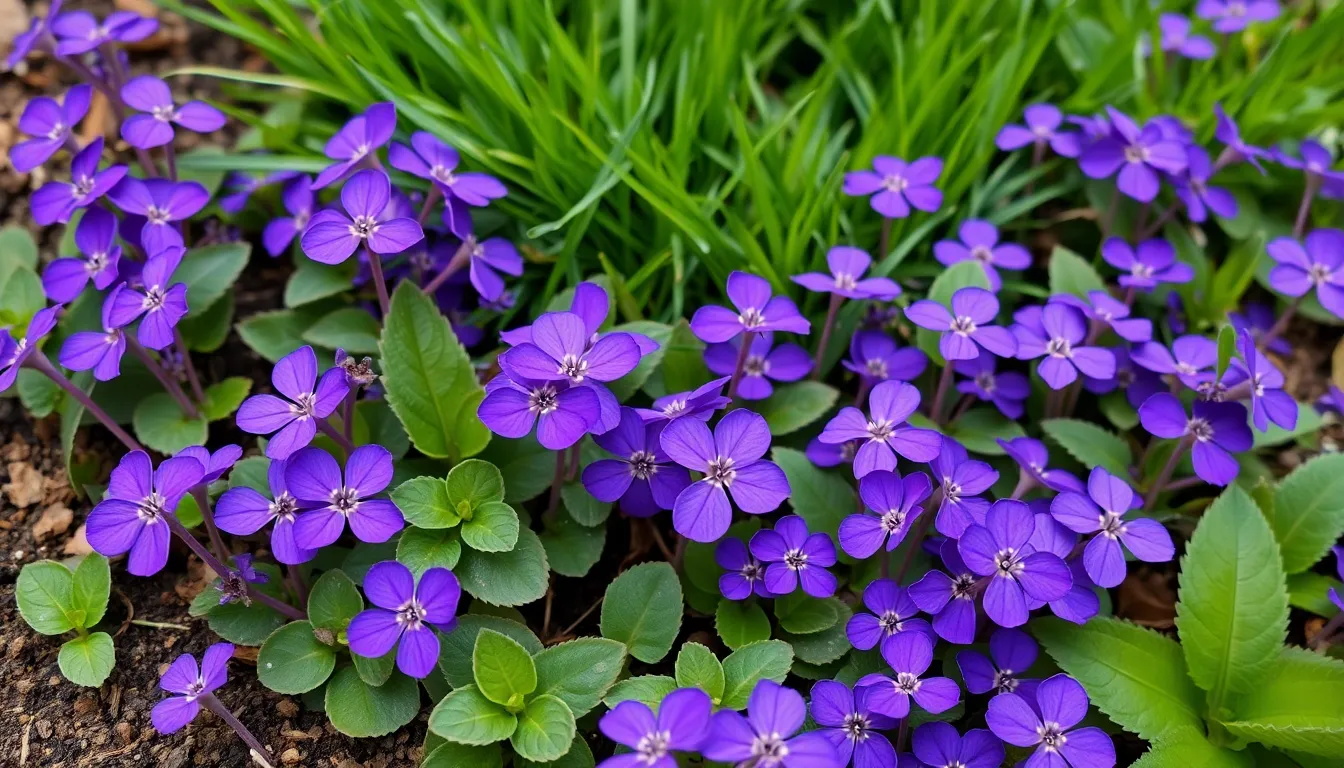
These hardy purple flowering plants adapt remarkably well to challenging growing conditions where other vegetation struggles. We’ll explore two standout species that demonstrate exceptional resilience in nutrient poor environments.
Creeping Charlie Adaptive Traits
Creeping Charlie (Glechoma hederacea) demonstrates remarkable versatility across diverse soil conditions, from dry to moist environments while tolerating partial shade. This purple flowering weed spreads aggressively through underground rhizomes, enabling rapid colonization of new territories throughout lawns and garden spaces.
Dense mats form quickly as Creeping Charlie establishes itself, effectively blocking sunlight from reaching competing lawn grasses below. Compacted soils present no barrier to this resilient species, making it particularly successful in areas where traditional turf grass fails to establish.
Key adaptive characteristics include:
- Thriving in various moisture levels and soil compaction
- Spreading through extensive underground stem networks
- Forming thick ground coverage that suppresses competition
- Growing successfully in both sun and shade conditions
Purple Clover Nitrogen-Fixing Benefits
Purple Clover (Trifolium pratense) offers important soil improvement capabilities through its natural nitrogen fixation process. This leguminous plant enhances soil fertility by converting atmospheric nitrogen into plant available forms, creating better growing conditions for surrounding vegetation.
Agricultural applications frequently use purple clover as a cover crop specifically for its soil enriching properties. Poor soil conditions become substantially more fertile after purple clover establishment, as the plant adds essential nutrients that benefit subsequent plantings.
Nitrogen fixation advantages provide:
| Benefit Category | Exact Impact |
|---|---|
| Soil Fertility | Adds 40-200 pounds nitrogen per acre annually |
| Soil Structure | Improves drainage and root penetration |
| Organic Matter | Increases soil carbon content when decomposed |
| Cost Savings | Reduces need for synthetic fertilizer applications |
Farmers and gardeners appreciate purple clover’s dual role as both ground cover and natural fertilizer, making it valuable for sustainable land management practices.
Tall Purple Flowering Weeds That Dominate Garden Borders

Several towering purple flowered weeds can quickly overtake garden spaces and borders, creating management challenges for homeowners. These aggressive species require immediate attention to prevent widespread invasion.
Bull Thistle Aggressive Spreading
Bull Thistle (Cirsium vulgare) stands as one of the most formidable tall purple weeds we encounter in garden borders. This biennial or perennial weed spreads aggressively through wind dispersed seeds, making it incredibly difficult to contain once established. We recognize bull thistle by its distinctive spiny appearance and large purple flower heads that can tower over surrounding plants.
Control methods for bull thistle require complete removal of the entire plant including all root systems to prevent regrowth. Hand pulling works best for small infestations, but we must wear thick gloves due to the sharp spines. Cutting the plant before it sets seed helps reduce future populations, though multiple treatments throughout the growing season become necessary for effective management.
Purple Loosestrife Wetland Invasion
Purple Loosestrife (Lythrum salicaria) presents one of the most aggressive invasive challenges we face, particularly in wetland areas and moist garden borders. This highly invasive perennial grows between 4 to 10 feet tall and produces striking magenta purple flowers that can severely disrupt native ecosystems. We often find purple loosestrife spreading rapidly through wet areas where it outcompetes native vegetation.
Effective control of purple loosestrife involves removing the entire root system before the plant establishes deep underground networks. Chemical herbicides applied during the flowering stage provide the most successful results, though we must apply treatments repeatedly over multiple seasons. Manual removal works for small patches, but we need to ensure every piece of root gets extracted to prevent aggressive regrowth in the following season.
Early Spring Purple Weeds That Emerge Before Grass Awakens
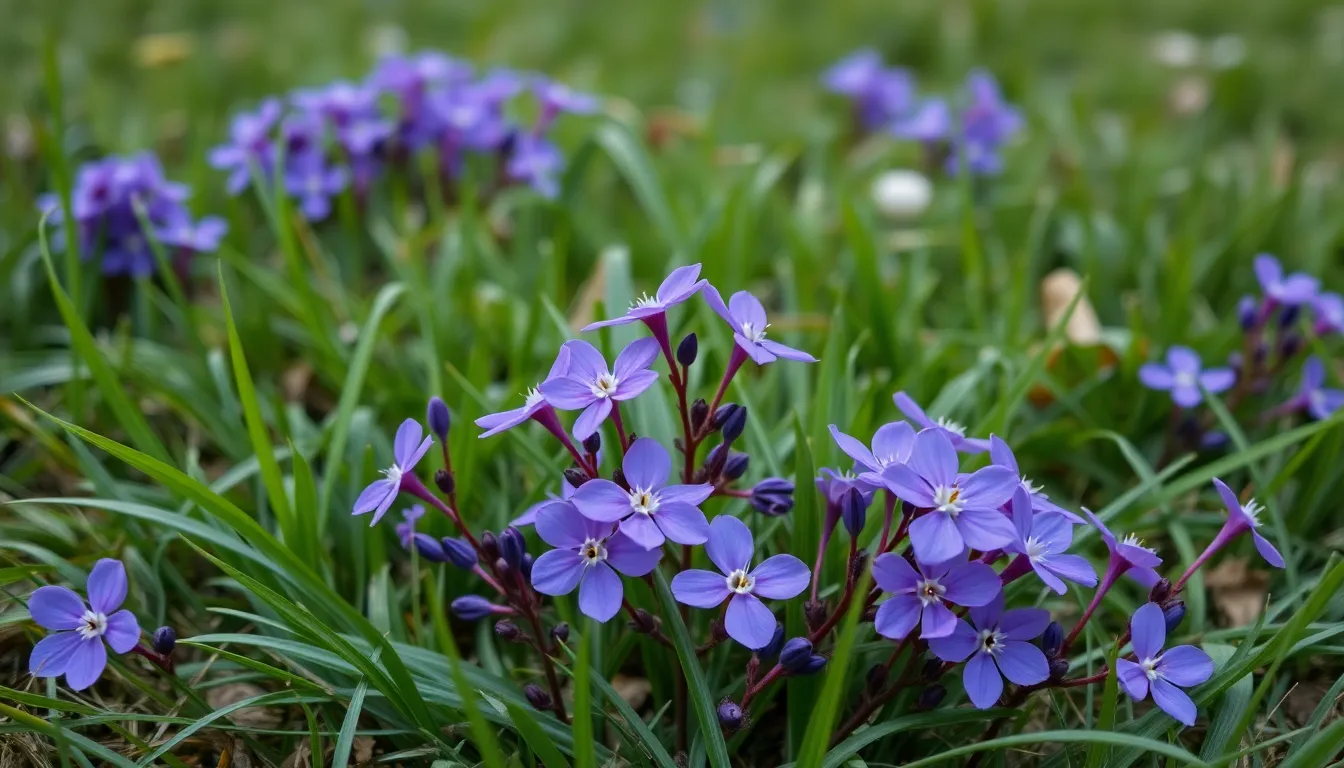
Spring brings a unique opportunity to spot purple flowering weeds as they emerge in dormant lawns. We notice these hardy plants taking advantage of cool temperatures and reduced competition from inactive grass.
Violet Wood Sorrel Timing
Violet wood sorrel appears during the early weeks of spring when temperatures remain cool. We find this delicate purple flowered plant establishing itself in gardens and lawns before other vegetation becomes active. Unlike its more aggressive cousins, violet wood sorrel grows at a moderate pace and rarely forms the dense colonies that characterize other spring weeds.
Gardeners often overlook violet wood sorrel because it doesn’t create the same visual impact as henbit or purple deadnettle. We observe that its smaller purple blooms and heart shaped leaves make it less noticeable during rapid spring growth periods. This timing allows violet wood sorrel to complete much of its reproductive cycle before homeowners begin intensive lawn care routines.
Dead Nettle Seasonal Appearance
Purple deadnettle emerges as one of the first weeds we encounter each spring season. This mint family member begins sprouting when soil temperatures reach approximately 40°F, often appearing in February and March across most regions. We notice purple deadnettle forming dense mats that can cover important lawn areas before grass awakens from winter dormancy.
Dead nettle grows rapidly during cool spring weather, reaching maturity within 6 to 8 weeks of emergence. We observe that its distinctive purple flowers and square stems become prominent features in early spring landscapes. This aggressive growth pattern allows purple deadnettle to establish extensive root systems and complete seed production before warm season competition intensifies.
Ground ivy follows a similar early spring timeline, producing small lavender to blue purple flowers from April through June. We find that this creeping weed takes advantage of the same dormant grass conditions that benefit purple deadnettle and henbit.
Purple Weeds With Medicinal and Culinary Uses Throughout History
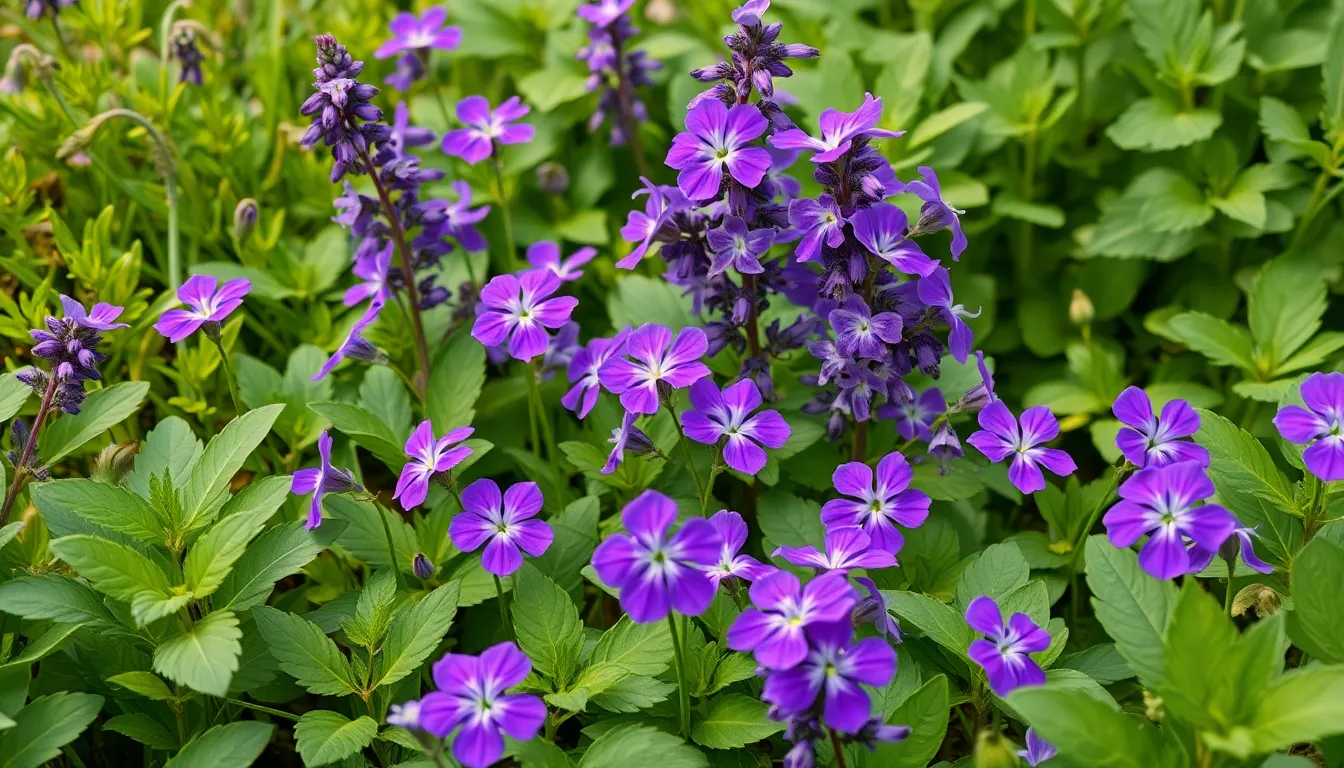
Throughout centuries, purple flowering weeds have served dual purposes in both kitchen gardens and medicine cabinets. We’ve discovered that many species dismissed as troublesome weeds actually offer remarkable healing properties and culinary applications.
Violets Transform Gardens Into Natural Pharmacies
Violets (Viola species) stand out as one of our most versatile purple flowering weeds with extensive medicinal applications. Sweet violet (Viola odorata) has treated headaches and various skin conditions for generations, while the Romans incorporated these delicate purple flowers directly into their daily meals as both food and garnish.
Self Heal (Prunella vulgaris) earned its common name through centuries of wound healing applications. Traditional healers valued this small purple flowered plant for treating mouth and throat diseases, and modern practitioners still recommend it as tea or fresh salad additions.
Henbit (Lamium amplexicaule) provides another example of medicinal purple weeds that our ancestors relied upon. Historical records show this plant effectively treated fevers and eased body aches, though it lacks important culinary applications compared to other purple flowering species.
Plantain Traditional Applications
Plantain serves as a cornerstone of traditional herbal medicine even though not producing typical purple flowers. We recognize this common weed for its exceptional ability to treat skin irritations and minor wounds through direct application of crushed leaves.
Traditional healers applied fresh plantain leaves directly to cuts, scrapes, and insect bites for immediate relief. Native American tribes called plantain “white man’s footprint” because it followed European settlers, and they quickly adopted it for treating various skin ailments and respiratory issues.
Wild Mint Harvesting Guidelines
Wild mint requires exact timing and techniques for optimal potency, though most varieties don’t produce purple flowers. We recommend harvesting just before the flowering stage when leaf oils reach peak concentration.
Timing determines the quality of your wild mint harvest. Cut stems during morning hours after dew evaporates but before afternoon heat reduces essential oil content.
Technique involves cutting the top third of each stem while leaving sufficient growth for plant recovery. This method ensures continuous harvests throughout the growing season.
Preservation starts immediately after cutting by drying leaves promptly in well ventilated areas away from direct sunlight. Proper drying maintains the potent flavors and medicinal properties that make wild mint valuable for teas, cooking applications, and natural remedies.
Effective Natural Methods for Managing Purple-Flowered Weed Populations
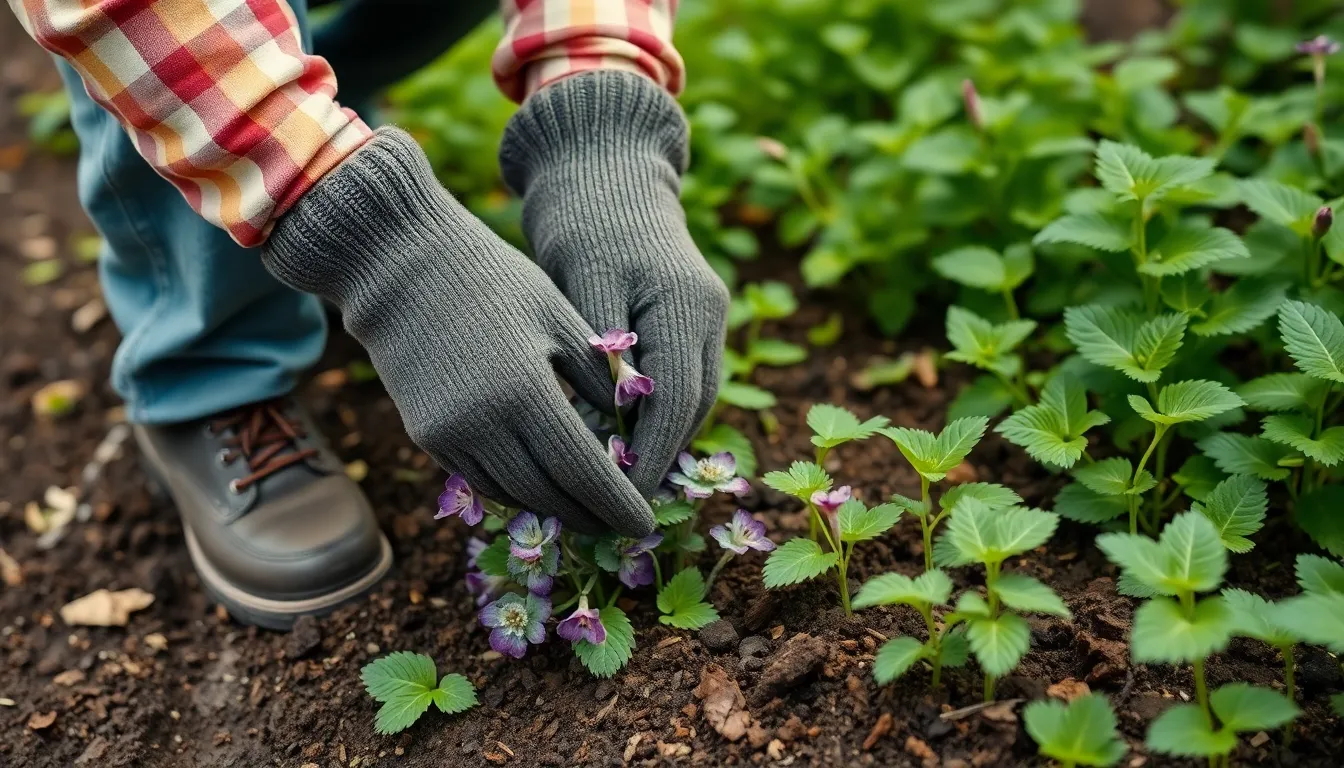
Natural weed control methods offer environmentally friendly alternatives to chemical herbicides while protecting beneficial plants in your garden. These organic approaches work particularly well for managing purple flowering weeds without disrupting soil health or harming nearby vegetation.
Hand-Pulling Techniques
Manual removal stands as the most effective natural method for controlling purple flowering weeds. We recommend this labor intensive approach especially for small infestations where complete root extraction prevents regrowth. The entire root system must come out to ensure the weed won’t return next season.
Timing your pulling efforts makes a important difference in success rates. We suggest removing purple deadnettle and henbit when soil moisture levels are high, as this makes root extraction much easier. Spring conditions after rain provide ideal circumstances for thorough removal.
Protection becomes essential when handling spiny purple weeds like bull thistle and musk thistle. We always wear thick gloves to shield our hands from thorns and potential skin irritants. These protective measures prevent injury while ensuring complete weed removal from your garden spaces.
Organic Suppression Strategies
Mulching creates an effective barrier that blocks sunlight from reaching weed seeds. We apply thick organic mulch layers around desired plants to prevent purple flowering weed germination. This method works particularly well against annual weeds like purple deadnettle that rely on light for sprouting.
Companion planting establishes natural competition that suppresses unwanted purple weeds. We strategically place beneficial plants that compete for resources or naturally repel invasive species. Dense plantings of desirable vegetation leave little room for weeds like ground ivy to establish themselves.
Crop rotation combined with regular tillage disrupts the life cycles of persistent purple weeds. We use these methods to break the growth patterns of perennial species while reducing their population density over time. This approach works especially well for managing deep rooted purple weeds.
Boiling water application provides an immediate chemical free solution for spot treatments. We pour hot water directly over individual purple weeds to kill them instantly without affecting soil chemistry. But, we exercise caution near desirable plants to avoid accidental damage from heat exposure.
Chemical-Free Prevention Strategies for Purple Weed Control
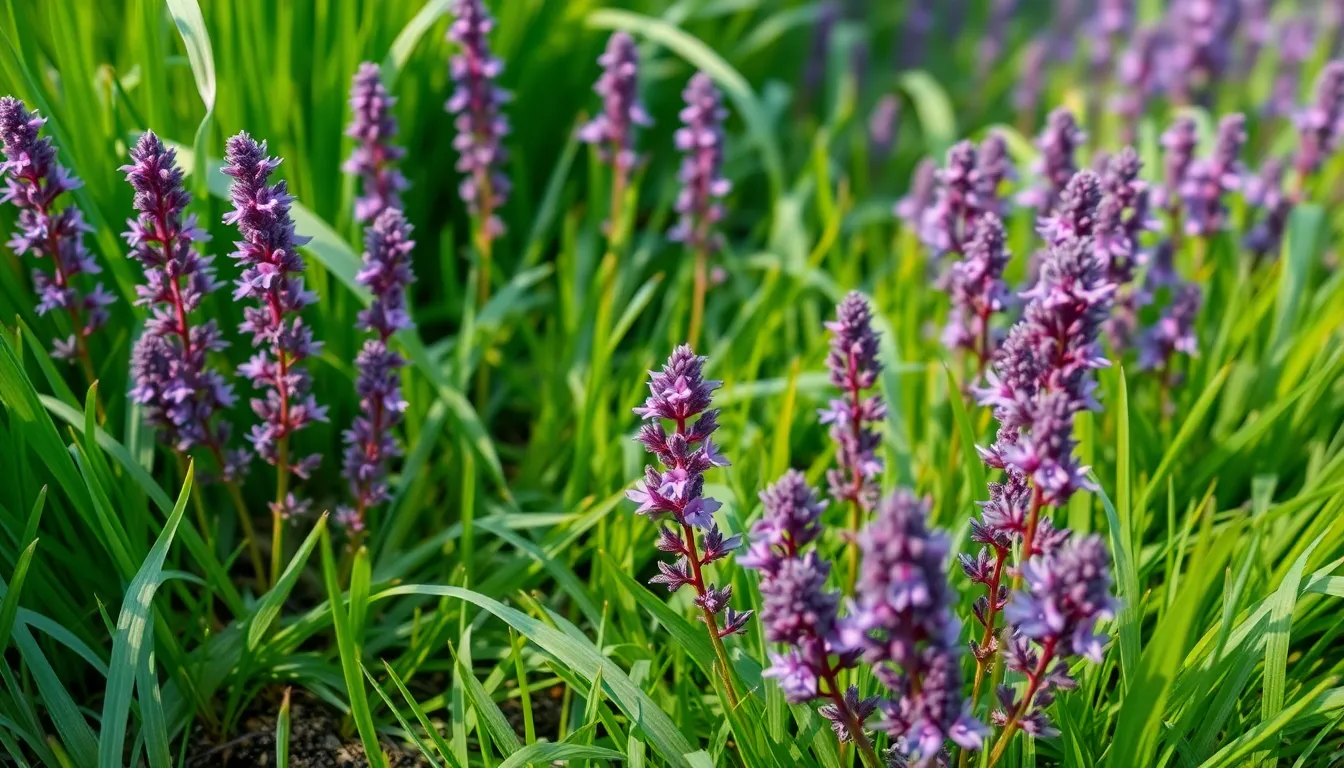
We can control purple flowering weeds naturally by focusing on preventative measures rather than reactive treatments. These methods strengthen our existing industry while reducing weed pressure through environmental management.
Soil Health Improvement
Healthy soil creates conditions that favor desired plants over weeds. Regular soil testing helps us identify nutrient deficiencies and pH imbalances that weeds like purple deadnettle exploit to establish themselves.
Balanced fertilization promotes strong root systems in our desired plants, making them more competitive against purple flowering invaders. Proper irrigation maintains optimal soil moisture levels that discourage weed germination while supporting healthy plant growth.
Organic matter additions improve soil structure and water retention, creating an environment where beneficial plants thrive. Compost, aged manure, and leaf mold increase microbial activity that naturally suppresses weed seeds through biological competition.
Dense Grass Establishment
Thick grass coverage physically prevents purple weeds from accessing sunlight and soil nutrients they need to germinate. Regular mowing at the correct height encourages dense growth patterns that crowd out potential weed seedlings.
Soil aeration through dethatching or core aeration promotes healthy root development in grass, leading to stronger turf density. Well aerated soil allows grass roots to access nutrients more effectively, creating natural competition against purple flowering weeds.
Overseeding thin areas eliminates bare spots where weeds typically establish first footholds. We should focus on these vulnerable areas during fall and early spring when grass seed has optimal germination conditions.
Natural mulching around garden beds creates physical barriers that block weed emergence. Organic mulches like pine bark, straw, or cedar suppress purple weeds by preventing sunlight from reaching dormant seeds while improving soil health over time.
Conclusion
We’ve discovered that purple-flowered weeds aren’t simply garden nuisances to eliminate—they’re complex plants with fascinating histories and ecological roles. From violets with their medicinal properties to self-heal’s wound-healing benefits these species have supported human communities for generations.
The key lies in understanding which purple bloomers deserve our appreciation and which require active management. Native wildflowers like Wild Bergamot support pollinators and enhance biodiversity while invasive species like Purple Loosestrife threaten local ecosystems.
Whether you choose natural removal methods or preventive strategies through soil health and dense grass establishment remember that effective weed management starts with proper identification. By recognizing the difference between beneficial native plants and problematic invaders we can create gardens that celebrate nature’s purple beauty while maintaining the balance our landscapes need.
Frequently Asked Questions
What are the most common purple-flowered weeds found in gardens?
The most common purple-flowered weeds include wild violets, purple deadnettle, ground ivy (Creeping Charlie), henbit, and purple clover. These plants typically appear in early spring and can quickly establish themselves in lawns and garden beds due to their resilience and ability to thrive in various soil conditions.
Are purple-flowered weeds always harmful to my garden?
Not necessarily. Many purple-flowered plants labeled as “weeds” are actually beneficial native wildflowers like Self-Heal and Wild Bergamot. These plants support pollinators, improve soil health, and have medicinal properties. However, invasive species like purple loosestrife can be problematic and require management.
How can I identify purple deadnettle versus other purple weeds?
Purple deadnettle has distinctive square stems, heart-shaped serrated leaves, and small purple flowers clustered at the top. It emerges early in spring, forming dense mats. Unlike other purple weeds, it grows rapidly in cool temperatures and has a less aggressive appearance compared to thistles.
What natural methods work best for controlling invasive purple weeds?
Manual removal is most effective, especially for small infestations. Remove weeds before they set seed, ideally when soil is moist. Other natural methods include mulching, boiling water treatments for spot control, maintaining thick grass coverage, and companion planting to suppress weed growth.
Do purple-flowered weeds have any medicinal or culinary uses?
Yes, many have historical uses. Wild violets are edible and rich in vitamins, Self-Heal treats wounds and inflammation, and henbit has traditional medicinal applications. However, proper identification is crucial before use, and some species may require specific harvesting techniques to preserve their beneficial properties.
When is the best time to remove purple flowering weeds?
Early spring is optimal, before weeds set seed and while they’re actively growing. Remove them when soil is moist for easier extraction. For perennial species, multiple removal sessions throughout the growing season may be necessary to exhaust root systems and prevent regrowth.
How can I prevent purple weeds from returning to my lawn?
Focus on soil health through regular testing, balanced fertilization, and organic matter additions. Maintain thick grass coverage through overseeding, proper aeration, and consistent watering. Use natural mulching around garden beds and practice crop rotation to disrupt weed growth cycles naturally.
Are there beneficial purple wildflowers I shouldn’t remove?
Yes, native species like Self-Heal (Prunella vulgaris) and Wild Bergamot (Monarda fistulosa) support local ecosystems. These plants attract pollinators, have medicinal properties, and improve soil health. Learn to distinguish between beneficial natives and invasive species before removal.






